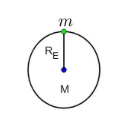
The value of acceleration due to gravity:
A.)is same on equator and poles
B.)is least on poles
C.)is least on equator
D.)increases from pole to equator
Answer
579.6k+ views
Hint: Using Newton’s law of gravitation find the equation of gravitational constant and acceleration due to gravity. And according to the formula use the relation between acceleration due ro gravity and radius.
Formula used:
$ g=\quad G\dfrac { M }{ { R }_{ E }^{ 2 } }$
Complete step-by-step answer:
Equation of gravitational constant and acceleration due to gravity can be calculated as shown below:

Suppose, a body of mass m is placed on the surface of earth and assumes the shape of the earth to be round. If mass of the earth is M and radius of earth is $ { R }_{ E }$, then by Newton’s law of gravitation we get,
$ F=\quad G\dfrac { Mm }{ { R }_{ E }^{ 2 } }$ …(1)
where, G: Gravitational Constant
Now, from Newton’s Second law of motion,
$ F=\quad mg$ …(2)
where, g: Acceleration due to gravity
From eq.(1) and eq.(2) we get,
$ mg=\quad G\dfrac { Mm }{ { R }_{ E }^{ 2 } }$
$ \therefore \quad g=\quad G\dfrac { M }{ { R }_{ E }^{ 2 } }$
So from the above equation, we can say the value of acceleration due to gravity is least at the maximum radius. Radius is maximum at the equator which means acceleration due to gravity is least at equator.
So, the correct answer is “Option C”.
Note:
As the radius increases acceleration due to gravity decreases. And similarly as the height from the surface of earth increases, acceleration due to gravity decreases. This is given by equation,
$g=\quad G\dfrac { M }{ { ({ R }_{ E }+h) }^{ 2 } } $
where, h: height from the surface of earth
Formula used:
$ g=\quad G\dfrac { M }{ { R }_{ E }^{ 2 } }$
Complete step-by-step answer:
Equation of gravitational constant and acceleration due to gravity can be calculated as shown below:

Suppose, a body of mass m is placed on the surface of earth and assumes the shape of the earth to be round. If mass of the earth is M and radius of earth is $ { R }_{ E }$, then by Newton’s law of gravitation we get,
$ F=\quad G\dfrac { Mm }{ { R }_{ E }^{ 2 } }$ …(1)
where, G: Gravitational Constant
Now, from Newton’s Second law of motion,
$ F=\quad mg$ …(2)
where, g: Acceleration due to gravity
From eq.(1) and eq.(2) we get,
$ mg=\quad G\dfrac { Mm }{ { R }_{ E }^{ 2 } }$
$ \therefore \quad g=\quad G\dfrac { M }{ { R }_{ E }^{ 2 } }$
So from the above equation, we can say the value of acceleration due to gravity is least at the maximum radius. Radius is maximum at the equator which means acceleration due to gravity is least at equator.
So, the correct answer is “Option C”.
Note:
As the radius increases acceleration due to gravity decreases. And similarly as the height from the surface of earth increases, acceleration due to gravity decreases. This is given by equation,
$g=\quad G\dfrac { M }{ { ({ R }_{ E }+h) }^{ 2 } } $
where, h: height from the surface of earth
Recently Updated Pages
Master Class 11 Chemistry: Engaging Questions & Answers for Success

Why are manures considered better than fertilizers class 11 biology CBSE

Find the coordinates of the midpoint of the line segment class 11 maths CBSE

Distinguish between static friction limiting friction class 11 physics CBSE

The Chairman of the constituent Assembly was A Jawaharlal class 11 social science CBSE

The first National Commission on Labour NCL submitted class 11 social science CBSE

Trending doubts
What is meant by exothermic and endothermic reactions class 11 chemistry CBSE

What are Quantum numbers Explain the quantum number class 11 chemistry CBSE

What is periodicity class 11 chemistry CBSE

Explain zero factorial class 11 maths CBSE

What is a periderm How does periderm formation take class 11 biology CBSE

Mention the basic forces in nature class 11 physics CBSE




